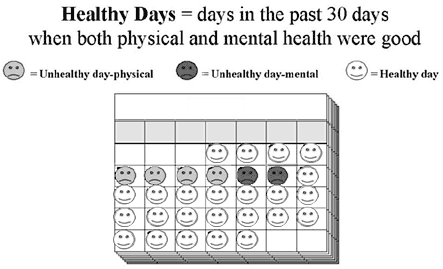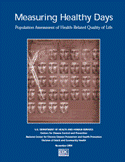Methods and Measures
- How Does CDC Measure Population Health-Related Quality of Life?
- Health-Related Quality of Life Measures
- Measurement Properties
- Origins and Use of CDC HRQOL Measures and Data
- How is the Summary Index of Unhealthy Days Calculated?
- SAS, SPSS and SUDAAN Syntax
How Does CDC Measure Population Health-Related Quality of Life?
CDC uses a set of questions called the “Healthy Days Measures.” These questions include the following:
- Would you say that in general your health is excellent, very good, good, fair, or poor?
- Now thinking about your physical health, which includes physical illness and injury, how many days during the past 30 days was your physical health not good?
- Now thinking about your mental health, which includes stress, depression, and problems with emotions, how many days during the past 30 days was your mental health not good?
- During the past 30 days, approximately how many days did poor physical or mental health keep you from doing your usual activities, such as self-care, work, or recreation?
Health-Related Quality of Life Measures
Health-Related Quality of Life Measures (English)
Health-Related Quality of Life Measures (Spanish)
This section includes the 4 core questions above, and 10 additional questions about health-related quality of life. These questions ask about recent pain, depression, anxiety, sleeplessness, vitality, and the cause, duration, and severity of a current activity limitation an individual may have in his or her life.
Origins and Use of CDC HRQOL Measures and Data
Since 1993, the four core Healthy Days measures have been part of the state based BRFSS’s full sample. Also starting in 2000, the Healthy Days Measures were added to the examination component of the National Health and Nutrition Examination Survey (NHANES). The demonstrated value of these measures and the continuous accumulation of public domain data have resulted in support from the CDC Disability, Women’s Health, and Arthritis Programs. The HRQOL measures and data also have been used for research or program planning by CDC’s Cardiovascular Health and HIV/AIDS Programs as well as by the Public Health Foundation, the Foundation for Accountability, and several other government and academic programs.
In recent years, several organizations have found these Healthy Days measures useful at the national level for (1) identifying health disparities, (2) tracking population trends, and (3) building broad coalitions around a measure of population health compatible with the World Health Organization’s definition of health.
| “Health is a state of complete physical, mental, and social well-being, and not merely the absence of disease or infirmity.” |
One of the greatest anticipated uses of the BRFSS Healthy Days measures and data is at the state and local levels for tracking overall progress on achieving Healthy People 2020 goals.
How is the Summary Index of Unhealthy Days Calculated?
Unhealthy days are an estimate of the overall number of days during the previous 30 days when the respondent felt that either his or her physical or mental health was not good. To obtain this estimate, responses to questions 2 and 3 are combined to calculate a summary index of overall unhealthy days, with a logical maximum of 30 unhealthy days. For example, a person who reports 4 physically unhealthy days and 2 mentally unhealthy days is assigned a value of 6 unhealthy days, and someone who reports 30 physically unhealthy days and 30 mentally unhealthy days is assigned the maximum of 30 unhealthy days.
Healthy days are the positive complementary form of unhealthy days. Healthy days estimates the number of recent days when a person’s physical and mental health was good (or better) and is calculated by subtracting the number of unhealthy days from 30 days.

The method for estimating unhealthy days is supported by the actual pattern of survey responses to two individual questions. The majority of individuals report substantially different numbers of physically unhealthy days versus mentally unhealthy days; for example, in the 1998 Behavioral Risk Factor Surveillance System (BRFSS) 67.8% of the 68,619 adults who reported any unhealthy days, reported only physically unhealthy days or mentally unhealthy days, while 4.5% reported equal numbers for each measure. Additional evidence indicates that other reported days do not overlap; for example, 10.5% of the 256 persons who reported both 15 physically unhealthy days and 15 mentally unhealthy days also reported more than 15 days of recent activity limitation due to poor physical or mental health. An alternative calculation method that assumed a maximum amount of overlap in the two responses (e.g., a person who reports 4 physically unhealthy days and 2 mentally unhealthy days is assigned a value of 4 unhealthy days) was not as plausible from the overall response pattern. Furthermore, this latter method resulted in only a 0.4-day overall mean difference in unhealthy days compared with the recommended method and showed similar demographic patterns and subgroup differences with aggregated population data.
SAS, SPSS, and SUDAAN syntax to correctly recode or create the Healthy Days Measures. For additional questions about the syntax, please send the Health-Related Quality of Life Assessment staff a message. Please e-mail us.
